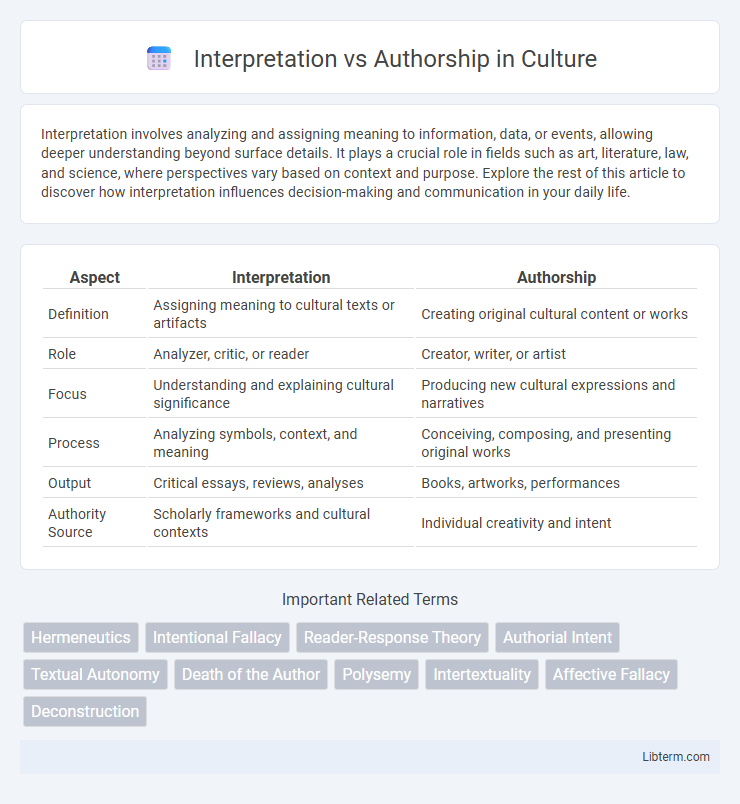Interpretation involves analyzing and assigning meaning to information, data, or events, allowing deeper understanding beyond surface details. It plays a crucial role in fields such as art, literature, law, and science, where perspectives vary based on context and purpose. Explore the rest of this article to discover how interpretation influences decision-making and communication in your daily life.
Table of Comparison
| Aspect | Interpretation | Authorship |
|---|---|---|
| Definition | Assigning meaning to cultural texts or artifacts | Creating original cultural content or works |
| Role | Analyzer, critic, or reader | Creator, writer, or artist |
| Focus | Understanding and explaining cultural significance | Producing new cultural expressions and narratives |
| Process | Analyzing symbols, context, and meaning | Conceiving, composing, and presenting original works |
| Output | Critical essays, reviews, analyses | Books, artworks, performances |
| Authority Source | Scholarly frameworks and cultural contexts | Individual creativity and intent |
Understanding Interpretation and Authorship
Understanding interpretation involves analyzing how meaning is derived from a text or work, emphasizing the role of the audience's perspective and context. Authorship centers on the creator's intent, voice, and originality, which shape the foundational meaning and purpose of the work. Distinguishing between these concepts clarifies how meaning can evolve through reception while remaining anchored in the author's original expression.
Definitions: Interpretation vs Authorship
Interpretation involves analyzing and explaining the meaning of a text, artwork, or data based on existing content and context, emphasizing the receiver's perspective and understanding. Authorship refers to the origin or creation of a work, highlighting the creator's intent, originality, and responsibility for the content. While interpretation centers on decoding and signifying, authorship is concerned with production and ownership of the material.
Historical Perspectives on Authorship
Historical perspectives on authorship reveal shifting views on the creator's role and the text's meaning within literary and cultural discourses. Classical antiquity often emphasized oral tradition and collective storytelling, while the Renaissance marked a rise in individual authorial identity tied to expanding print culture. The Romantic era further idealized authorship as a unique expression of personal genius, contrasting with postmodern critiques that question fixed meanings and the notion of singular authorship.
The Role of the Reader in Interpretation
The role of the reader in interpretation is central, as meaning is co-constructed through the interaction between the text and the reader's perspective, cultural context, and prior knowledge. Reader-response theory emphasizes that interpretations vary widely depending on individual experiences, making authorship less authoritative in determining a fixed meaning. This dynamic highlights the fluidity of meaning, where readers actively engage with the text to generate diverse understandings beyond the author's original intent.
Authorial Intent vs Reader Response
Authorial intent emphasizes understanding a text based on the author's original purpose, context, and intended meaning, often guiding interpretive analysis through historical and biographical details. Reader response theory prioritizes the individual reader's experience and emotional engagement, arguing that meaning is co-created through interaction with the text. The tension between these approaches highlights whether meaning resides primarily in the author's design or the reader's subjective interpretation.
Interpretive Theories in Literary Criticism
Interpretive theories in literary criticism emphasize the reader's role in constructing meaning, diverging from traditional authorship-centered approaches that prioritize authorial intent. Hermeneutics and Reader-Response Theory highlight how cultural context, personal experience, and textual interaction influence interpretation, positioning the text as a dynamic site for diverse meanings. These models challenge the Fixed Meaning Theory, advocating for a pluralistic understanding of literature where interpretation shapes rather than merely reflects authorial creation.
Cultural Influences on Interpretation
Cultural influences shape interpretation by framing how audiences perceive and understand texts, art, or media through the lens of their unique historical, social, and linguistic contexts. Variations in cultural background can lead to diverse meanings and emotional responses, underscoring the dynamic relationship between interpretation and authorship. Recognizing these cultural filters highlights the fluidity of meaning beyond the author's original intent, emphasizing the interpretive role of the audience.
Case Studies: Conflicts Between Author and Interpreter
Case studies reveal frequent conflicts between authorial intent and interpreter perspective, highlighting discrepancies in textual meaning. Legal disputes and literary analyses often underscore how interpretation can diverge significantly from the author's original purpose, leading to contested understandings. Prominent examples include copyright cases and literary reinterpretations, emphasizing the tension between fixed authorship and dynamic interpretation.
The Impact of Digital Media on Authorship
Digital media has transformed authorship by enabling collaborative content creation across global platforms, increasing the diversity of voices and challenging traditional notions of single-author ownership. The rise of digital tools facilitates real-time revisions, audience interaction, and the blending of multiple interpretations within a single work, complicating the authority of original authors. This shift emphasizes the fluidity of texts and the importance of recognizing collective intellectual contributions in digital environments.
Balancing Interpretation and Authorship in Modern Discourse
Balancing interpretation and authorship in modern discourse involves recognizing the fluidity of meaning as texts interact with diverse audiences and contexts. Interpretation extends the life of a work by allowing multiple perspectives, while authorship anchors the original intent and creative authority behind the text. Effective discourse navigates this dynamic by valuing both the writer's voice and the evolving interpretations that readers bring, fostering a richer understanding of literary and cultural artifacts.
Interpretation Infographic

 libterm.com
libterm.com